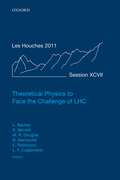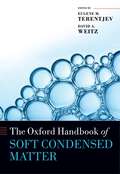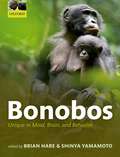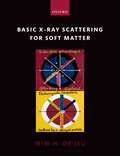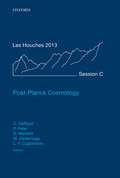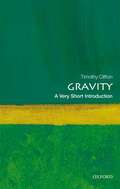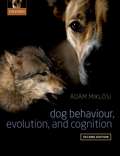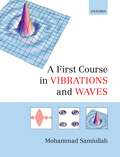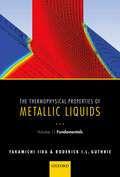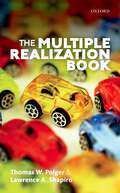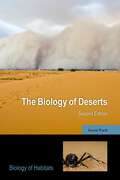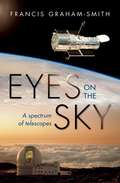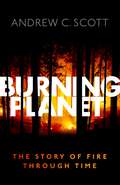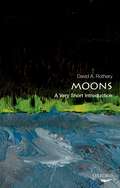- Table View
- List View
Theoretical Physics to Face the Challenge of LHC: Lecture Notes of the Les Houches Summer School: Volume 97, August 2011 (Lecture Notes of the Les Houches Summer School #97)
The book gathers the lecture notes of the Les Houches Summer School that was held in August 2011 for an audience of advanced graduate students and post-doctoral fellows in particle physics, theoretical physics, and cosmology, areas where new experimental results were on the verge of being discovered at CERN. Every Les Houches School has its own distinct character. This one was held during a summer of great anticipation that at any moment contact might be made with the most recent theories of the nature of the fundamental forces and the structure of space-time. In fact, during the session, the long anticipated discovery of the Higgs particle was announced. The book vividly describes the fruitful and healthy "schizophrenia" that is the rule among the community of theoreticians who have split into several components: those doing phenomenology, and those dealing with highly theoretical problems, with a few trying to bridge both domains. The lectures by theoreticians covered many directions in the theory of elementary particles, from classics such as the Supersymmetric Standard Model to very recent ideas such as the relation between black holes, hydrodynamics, and gauge-gravity duality. The lectures by experimentalists explained in detail how intensively and how precisely the LHC collider has verified the theoretical predictions of the Standard Model, predictions that were at the front lines of experimental discovery during the 70's, 80's and 90's, and how the LHC is ready to make new discoveries. They described many of the ingenious and pioneering techniques developed at CERN for the detection and the data analysis of billions of billions of proton-proton collisions.
The Oxford Handbook of Soft Condensed Matter (Oxford Handbooks)
Soft condensed matter is a relatively new topic. Condensed matter has typically referred to more traditional liquids, which have a long history of study, or to solids, which have focused more commonly on hard materials, driven in large measure by the importance of structural materials or the metals and semiconductors which drove the rapid evolution of microelectronics. It is only relatively recently, over the past 20 to 30 years, that soft condensed matter has matured into its own identifiable field. However, the field is an amalgam of many subfields, and many of these have themselves much longer histories. This handbook serves as an overview of many of these topics. Because of the great breadth, it is impossible to include them all; nevertheless, the key subjects of soft condensed matter are represented here. Together, they form both an introduction and an overview of the field. Each topic, and its representing Chapter, could have been a full size book - in fact, there are a number of such books on many of the topics covered in the handbook. Our aim here was to give a current snapshot of the field, identify the key principles at play and the most prominent (and promising) ways of its further development, provide essential references for anyone to follow the subject, but not necessarily go into a lot of detail on each topic.
Bonobos: Unique in Mind, Brain, and Behavior
The bonobo, along with the chimpanzee, is one of our two closest living relatives. Their relatively narrow geographic range (south of the Congo River in the Democratic Republic of Congo) combined with the history of political instability in the region, has made their scientific study extremely difficult. In contrast, there are dozens of wild and captive sites where research has been conducted for decades with chimpanzees. Because data sets on bonobos have been so hard to obtain and so few large-scale studies have been published, the majority of researchers have treated chimpanzee data as being representative of both species. However, this misconception is now rapidly changing. With relative stability in the DRC for over a decade and a growing community of bonobos living in zoos and sanctuaries internationally, there has been an explosion of scientific interest in the bonobo with dozens of high impact publications focusing on this fascinating species. This research has revealed exactly how unique bonobos are in their brains and behavior, and reminds us why it is so important that we redouble our efforts to protect the few remaining wild populations of this iconic and highly endangered great ape species.
Basic X-Ray Scattering for Soft Matter
by Wim H. de JeuX-ray scattering is a well-established technique in materials science. Several excellent textbooks exist in this field, but these texts are typically written by physicists who use mathematics to make things clear. Consequently these books appeal less to students and scientists in the field of soft matter (polymers, liquid crystals, colloids, self-assembled organic systems) who usually have a more chemical-oriented background with limited mathematics. Moreover, they need to know about the technique of x-ray scattering, but do not intend to become an expert. The aim of this book is to explain basic principles and applications of x-ray scattering in a simple way using many practical examples followed by more elaborate case studies. The book contains a separate chapter on the different types of order/disorder in soft matter that play such an important role in modern self-assembling systems. Finally the last chapter treats soft matter surfaces and thin film that are increasingly used in coatings and in many technological applications, such as liquid crystal displays and nanostructured block copolymer films. This book has been written for the large community of soft matter students and scientists.
Post-Planck Cosmology: Lecture Notes of the Les Houches Summer School: Volume 100, July 2013 (Lecture Notes of the Les Houches Summer School #100)
by Leticia F. Cugliandolo Cédric Deffayet Patrick Peter Benjamin Wandelt Matías ZaldarriagaThis book gathers the lecture notes of the 100th Les Houches Summer School, which was held in July 2013. These lectures represent a comprehensive pedagogical survey of the frontier of theoretical and observational cosmology just after the release of the first cosmological results of the Planck mission. The Cosmic Microwave Background is discussed as a possible window on the still unknown laws of physics at very high energy and as a backlight for studying the late-time Universe. Other lectures highlight connections of fundamental physics with other areas of cosmology and astrophysics, the successes and fundamental puzzles of the inflationary paradigm of cosmic beginning, the themes of dark energy and dark matter, and the theoretical developments and observational probes that will shed light on these cosmic conundrums in the years to come.
Gravity: A Very Short Introduction (Very Short Introductions)
by Timothy CliftonGravity is one of the four fundamental interactions that exist in nature. It also has the distinction of being the oldest, weakest, and most difficult force to quantize. Understanding gravity is not only essential for understanding the motion of objects on Earth, but also the motion of all celestial objects, and even the expansion of the Universe itself. It was the study of gravity that led Einstein to his profound realisations about the nature of space and time. Gravity is not only universal, it is also essential for understanding the behaviour of the Universe, and all astrophysical bodies within it. In this Very Short Introduction Timothy Clifton looks at the development of our understanding of gravity since the early observations of Kepler and Newtonian theory. He discusses Einstein's theory of gravity, which now supplants Newton's, showing how it allows us to understand why the frequency of light changes as it passes through a gravitational field, why GPS satellites need their clocks corrected as they orbit the Earth, and why the orbits of distant neutron stars speed up. Today, almost 100 years after Einstein published his theory of gravity, we have even detected the waves of gravitational radiation that he predicted. Clifton concludes by considering the testing and application of general relativity in astrophysics and cosmology, and looks at dark energy and efforts such as string theory to combine gravity with quantum mechanics. ABOUT THE SERIES: The Very Short Introductions series from Oxford University Press contains hundreds of titles in almost every subject area. These pocket-sized books are the perfect way to get ahead in a new subject quickly. Our expert authors combine facts, analysis, perspective, new ideas, and enthusiasm to make interesting and challenging topics highly readable.
Gravity: A Very Short Introduction (Very Short Introductions)
by Timothy CliftonGravity is one of the four fundamental interactions that exist in nature. It also has the distinction of being the oldest, weakest, and most difficult force to quantize. Understanding gravity is not only essential for understanding the motion of objects on Earth, but also the motion of all celestial objects, and even the expansion of the Universe itself. It was the study of gravity that led Einstein to his profound realisations about the nature of space and time. Gravity is not only universal, it is also essential for understanding the behaviour of the Universe, and all astrophysical bodies within it. In this Very Short Introduction Timothy Clifton looks at the development of our understanding of gravity since the early observations of Kepler and Newtonian theory. He discusses Einstein's theory of gravity, which now supplants Newton's, showing how it allows us to understand why the frequency of light changes as it passes through a gravitational field, why GPS satellites need their clocks corrected as they orbit the Earth, and why the orbits of distant neutron stars speed up. Today, almost 100 years after Einstein published his theory of gravity, we have even detected the waves of gravitational radiation that he predicted. Clifton concludes by considering the testing and application of general relativity in astrophysics and cosmology, and looks at dark energy and efforts such as string theory to combine gravity with quantum mechanics. ABOUT THE SERIES: The Very Short Introductions series from Oxford University Press contains hundreds of titles in almost every subject area. These pocket-sized books are the perfect way to get ahead in a new subject quickly. Our expert authors combine facts, analysis, perspective, new ideas, and enthusiasm to make interesting and challenging topics highly readable.
Dog Behaviour, Evolution, and Cognition
by Adam MiklosiThis is the first book to collate and synthesize the recent burgeoning primary research literature on dog behaviour, evolution, and cognition. The author presents a new ecological approach to the understanding of dog behaviour, demonstrating how dogs can be the subject of rigorous and productive scientific study without the need to confine them to a laboratory environment. This second, fully updated edition of Dog Behaviour, Evolution and Cognition starts with an overview of the conceptual and methodological issues associated with the study of the dog, followed by a brief description of their role in human society. An evolutionary perspective is then introduced with a summary of current research into the process of domestication. The central part of the book is devoted to issues relating to the cognitive aspects of behaviour which have received particular attention in recent years from both psychologists and ethologists. The book's final chapters introduce the reader to many novel approaches to dog behaviour, set in the context of behavioural development and genetics. This second edition recognises and discusses the fact that dogs are increasingly being used as model organisms for studying aspects of human biology, such as genetic diseases and ageing. Specific attention is also given in this edition to attachment behaviour which emerges between humans and dogs, the importance of inter-specific communication in the success of dogs in human communities and the broad aspects of social cognition and how this may contribute to human-dog cooperation Directions for future research are highlighted throughout the text which also incorporates links to human and primate research by drawing on homologies and analogies in both evolution and behaviour. The book will therefore be of relevance and use to anyone with an interest in behavioural ecology including graduate students of animal behaviour and cognition, as well as a more general audience of dog enthusiasts, biologists, psychologists, veterinarians, and sociologists.
Dog Behaviour, Evolution, and Cognition
by Adam MiklosiThis is the first book to collate and synthesize the recent burgeoning primary research literature on dog behaviour, evolution, and cognition. The author presents a new ecological approach to the understanding of dog behaviour, demonstrating how dogs can be the subject of rigorous and productive scientific study without the need to confine them to a laboratory environment. This second, fully updated edition of Dog Behaviour, Evolution and Cognition starts with an overview of the conceptual and methodological issues associated with the study of the dog, followed by a brief description of their role in human society. An evolutionary perspective is then introduced with a summary of current research into the process of domestication. The central part of the book is devoted to issues relating to the cognitive aspects of behaviour which have received particular attention in recent years from both psychologists and ethologists. The book's final chapters introduce the reader to many novel approaches to dog behaviour, set in the context of behavioural development and genetics. This second edition recognises and discusses the fact that dogs are increasingly being used as model organisms for studying aspects of human biology, such as genetic diseases and ageing. Specific attention is also given in this edition to attachment behaviour which emerges between humans and dogs, the importance of inter-specific communication in the success of dogs in human communities and the broad aspects of social cognition and how this may contribute to human-dog cooperation Directions for future research are highlighted throughout the text which also incorporates links to human and primate research by drawing on homologies and analogies in both evolution and behaviour. The book will therefore be of relevance and use to anyone with an interest in behavioural ecology including graduate students of animal behaviour and cognition, as well as a more general audience of dog enthusiasts, biologists, psychologists, veterinarians, and sociologists.
A First Course in Vibrations and Waves
by Mohammad SamiullahThe study of vibrations and waves is central to physics and engineering disciplines.This text contains a detailed treatment of vibrations and waves at an introductory level suitable for second and third year students. It builds on first year physics and emphasizes understanding of vibratory motion and waves based on first principles. Since waves appear in almost all branches of physics and engineering, readers will be exposed to many different types of waves; this study aims to draw together their similarities, by examining them in a common language. The book is divided into three parts: Part I contains a preliminary chapter that serves as a review of relevant ideas of mechanics and complex numbers. Part II is devoted to a detailed discussion of vibrations of mechanical systems. This part covers simple harmonic oscillator, coupled oscillators, normal coordinates, beaded string, continuous string, and Fourier series. It concludes with a presentation of stationary solutions of driven finite systems. Part III is concerned with waves, focusing on the discussion of common aspects of all types of waves, and the applications to sound, electromagnetic, and matter waves are illustrated. Finally, relevant examples are provided at the end of the chapters to illustrate the main ideas, and better the reader's understanding.
Bonding, Structure and Solid-State Chemistry
by Mark LaddThis book provides a study in Bonding, Structure and Solid State Chemistry. It is based on lecture courses given over several years, but is not directed at any particular degree course. Thus, it will find a place in all years of first-degree courses in both chemistry and those subjects for which chemistry forms a significant part. It will also prepare readers for more intensive study in the title topics. Pre-knowledge is assumed in mathematics and physical sciences at about A-level. Additional mathematical and other topics are presented where necessary as appendices, so as not to disturb the flow of the main text. The book is copiously illustrated, including many stereoscopic diagrams (with practical advice on correct viewing) and colour illustrations. A suite of computer programs, some of which are interactive, has been devised for the book and is available on-line from the publisher's website [insert URL here]. They are available for both 32- and 64-bit operating systems, and are easily executed on a PC or laptop; notes on their applications are provided. Problems have been devised for each chapter and fully worked 'tutorial'; solutions are included. After an introductory chapter, the book presents a study based on the main interactive forces responsible for cohesion in the solid state of matter. No classification is without some ambiguity, but that chosen allows for a structured discussion over a wide range of compounds. Each chapter includes worked examples on the study topics which, together with the problems provided, should ensure a thorough understanding of the textual material.
The Thermophysical Properties of Metallic Liquids: Volume 1 : Fundamentals
by Takamichi Iida Roderick I. GuthrieThis first volume provides the basic matters needed for understanding the thermophysical properties of metallic liquids and for developing reliable models to accurately predict the thermophysical properties of almost all metallic elements in the liquid state, together with methods for quantitative assessment of models/equations. The authors also review the structure of metallic liquids, which is based on the theory of liquids, followed by density, volume expansivity, thermodynamic properties (evaporation enthalpy, vapour pressure, heat capacity), sound velocity, surface tension,viscosity, diffusion, and electrical and thermal conductivities. Finally, the essential points of methods used for measuring these experimental data are presented.
The Thermophysical Properties of Metallic Liquids: Volume 2 : Predictive models
by Takamichi Iida Roderick I. GuthrieVolume 2 considers the essential conditions for a model to be truly predictive. The authors use a statistical approach to rate the validity of the various predictive models that have been previously used for evaluating various thermophysical properties. On the basis of this assessment, the authors have predicted values for the thermophysical properties of elemental metallic liquids, which are lacking in experimental data. They believe their predicted values are at least as reliable, and sometimes more reliable than corresponding experimental values. According to the periodic law, the authors provide the periodic variations in values of some twelve physical quantities or thermophysical properties. This is based on the electron configuration in the outermost energy level of metallic elements. Finally, a large number of experimental data for the physical quantities and thermophysical properties of liquid metallic elements are compiled.
The Multiple Realization Book
by Thomas W. Polger Lawrence A. ShapiroSince Hilary Putnam offered multiple realization as an empirical hypothesis in the 1960s, philosophical consensus has turned against the idea that mental processes could be identified with brain processes, and multiple realization has become the keystone of the 'antireductive consensus' across philosophy of science broadly. Thomas W. Polger and Lawrence A. Shapiro offer the first book-length investigation of multiple realization. Their analysis of multiple realization serves as a starting point to a series of philosophically sophisticated and empirically informed arguments that cast doubt on the generality of multiple realization in the cognitive sciences. In the course of making their case, they respond to classic defenses of multiple realization that Jerry Fodor, Ned Block, and other prominent philosophers of psychology have offered. Polger and Shapiro conclude that the identity theory, once left for dead, remains a viable theory of mind—one that, when suitably framed, enjoys the benefits typically thought to accrue only to theories of mind that presuppose the truth of multiple realization. As Polger and Shapiro see matters, mind-brain identities have played an important role in the growth and achievements of the cognitive sciences, and they see little prospect—or need—for multiple realization in an empirically-based theory of mind. This leads Polger and Shapiro to offer an alternative framework for understanding explanations in the cognitive sciences, as well as in chemistry, biology, and other non-basic sciences.
Floral Mimicry
by Steven D. Johnson Florian P. SchiestlMimicry is a classic example of adaptation through natural selection. The traditional focus of mimicry research has been on defence in animals, but there is now also a highly-developed and rapidly-growing body of research on floral mimicry in plants. This has coincided with a revolution in genomic tools, making it possible to explore which genetic and developmental processes underlie the sometimes astonishing changes that give rise to floral mimicry. Being literally rooted to one spot, plants have to cajole animals into acting as couriers for their pollen. Floral mimicry encompasses a set of evolutionary strategies whereby plants imitate the food sources, oviposition sites, or mating partners of animals in order to exploit them as pollinators. This first definitive book on floral mimicry discusses the functions of visual, olfactory, and tactile signals, integrating them into a broader theory of organismal mimicry that will help guide future research in the field. It addresses the fundamental question of whether the evolutionary and ecological principles that were developed for protective mimicry in animals can also be applied to floral mimicry in plants. The book also deals with the functions of floral rewardlessness, a condition which often serves as a precursor to the evolution of mimicry in plant lineages. The authors pay particular attention to the increasing body of research on chemical cues: their molecular basis, their role in cognitive misclassification of flowers by pollinators, and their implications for plant speciation. Comprehensive in scope and conceptual in focus, Floral Mimicry is primarily aimed at senior undergraduates, graduate students, and researchers in plant science and evolutionary biology.
Floral Mimicry
by Steven D. Johnson Florian P. SchiestlMimicry is a classic example of adaptation through natural selection. The traditional focus of mimicry research has been on defence in animals, but there is now also a highly-developed and rapidly-growing body of research on floral mimicry in plants. This has coincided with a revolution in genomic tools, making it possible to explore which genetic and developmental processes underlie the sometimes astonishing changes that give rise to floral mimicry. Being literally rooted to one spot, plants have to cajole animals into acting as couriers for their pollen. Floral mimicry encompasses a set of evolutionary strategies whereby plants imitate the food sources, oviposition sites, or mating partners of animals in order to exploit them as pollinators. This first definitive book on floral mimicry discusses the functions of visual, olfactory, and tactile signals, integrating them into a broader theory of organismal mimicry that will help guide future research in the field. It addresses the fundamental question of whether the evolutionary and ecological principles that were developed for protective mimicry in animals can also be applied to floral mimicry in plants. The book also deals with the functions of floral rewardlessness, a condition which often serves as a precursor to the evolution of mimicry in plant lineages. The authors pay particular attention to the increasing body of research on chemical cues: their molecular basis, their role in cognitive misclassification of flowers by pollinators, and their implications for plant speciation. Comprehensive in scope and conceptual in focus, Floral Mimicry is primarily aimed at senior undergraduates, graduate students, and researchers in plant science and evolutionary biology.
The Biology of Deserts (Biology of Habitats Series)
by David WardThis book offers a concise but comprehensive introduction to desert ecology and adopts a strong evolutionary focus. As with other titles in the Biology of Habitats Series, the emphasis in the book is on the organisms that dominate this harsh environment, although theoretical and experimental aspects are also discussed. In this updated second edition, there is a greater focus on the effects of climate change and some of its likely effects on deserts, seeing desertification as among the most serious results of climate change, leading ultimately to the increasing size of arid and semi-arid regions. The Biology of Deserts Second Edition includes a wide range of ecological and evolutionary issues including morphological and physiological adaptations of desert plants and animals, species interactions, the importance of predation and parasitism, food webs, biodiversity, and conservation. It features a balance of plant and animal (both invertebrate and vertebrate) examples, and also emphasizes topical applied issues such as desertification and invasive species. The book concludes by considering the positive aspects of desert conservation. This accessible textbook is intended for senior undergraduate and graduate students, as well as professional ecologists, conservation practitioners, and resource managers working in the field of desert ecology.
The Biology of Deserts (Biology of Habitats Series)
by David WardThis book offers a concise but comprehensive introduction to desert ecology and adopts a strong evolutionary focus. As with other titles in the Biology of Habitats Series, the emphasis in the book is on the organisms that dominate this harsh environment, although theoretical and experimental aspects are also discussed. In this updated second edition, there is a greater focus on the effects of climate change and some of its likely effects on deserts, seeing desertification as among the most serious results of climate change, leading ultimately to the increasing size of arid and semi-arid regions. The Biology of Deserts Second Edition includes a wide range of ecological and evolutionary issues including morphological and physiological adaptations of desert plants and animals, species interactions, the importance of predation and parasitism, food webs, biodiversity, and conservation. It features a balance of plant and animal (both invertebrate and vertebrate) examples, and also emphasizes topical applied issues such as desertification and invasive species. The book concludes by considering the positive aspects of desert conservation. This accessible textbook is intended for senior undergraduate and graduate students, as well as professional ecologists, conservation practitioners, and resource managers working in the field of desert ecology.
Eyes on the Sky: A Spectrum of Telescopes
by Francis Graham-SmithFour centuries ago, Galileo first turned a telescope to look up at the night sky. His discoveries opened the cosmos, revealing the geometry and dynamics of the solar system. Today's telescopic equipment, stretching over the whole spectrum from visible light to radio and millimetre astronomy, through infrared to ultraviolet, X-rays and gamma rays, has again transformed our understanding of the whole Universe. In this book Francis Graham-Smith explains how this technology can be engaged to give us a more in-depth picture of the nature of the universe. Looking at both ground-based telescopes and telescopes on spacecraft, he analyses their major discoveries, from planets and pulsars to cosmology. Large research teams and massive data handling are necessary, but the excitement of discovery is increasingly shared by a growing public, who can even join in some of the analysis by remote computer techniques. Observational astronomy has become international. All major projects are now partnerships; most notably the Square Kilometre Array, which will involve astronomers from over 100 countries and will physically exist in several of them. Covering the history and development of telescopes from Galileo to the present day, Eyes on the Sky traces what happens when humankind looks up.
Eyes on the Sky: A Spectrum of Telescopes
by Francis Graham-SmithFour centuries ago, Galileo first turned a telescope to look up at the night sky. His discoveries opened the cosmos, revealing the geometry and dynamics of the solar system. Today's telescopic equipment, stretching over the whole spectrum from visible light to radio and millimetre astronomy, through infrared to ultraviolet, X-rays and gamma rays, has again transformed our understanding of the whole Universe. In this book Francis Graham-Smith explains how this technology can be engaged to give us a more in-depth picture of the nature of the universe. Looking at both ground-based telescopes and telescopes on spacecraft, he analyses their major discoveries, from planets and pulsars to cosmology. Large research teams and massive data handling are necessary, but the excitement of discovery is increasingly shared by a growing public, who can even join in some of the analysis by remote computer techniques. Observational astronomy has become international. All major projects are now partnerships; most notably the Square Kilometre Array, which will involve astronomers from over 100 countries and will physically exist in several of them. Covering the history and development of telescopes from Galileo to the present day, Eyes on the Sky traces what happens when humankind looks up.
Plasmonic Effects in Metal-Semiconductor Nanostructures (Series on Semiconductor Science and Technology #19)
by Alexey A. Toropov Tatiana V. ShubinaMetal-semiconductor nanostructures represent an important new class of materials employed in designing advanced optoelectronic and nanophotonic devices, such as plasmonic nanolasers, plasmon-enhanced light-emitting diodes and solar cells, plasmonic emitters of single photons, and quantum devices operating in infrared and terahertz domains. The combination of surface plasmon resonances in conducting structures, providing strong concentration of an electromagnetic optical field nearby, with sharp optical resonances in semiconductors, which are highly sensitive to external electromagnetic fields, creates a platform to control light on the nanoscale. The design of the composite metal-semiconductor system imposes the consideration of both the plasmonic resonances in metal and the optical transitions in semiconductors - a key issue being their resonant interaction providing a coupling regime. In this book the reader will find descriptions of electrodynamics of conducting structures, quantum physics of semiconductor nanostructures, and guidelines for advanced engineering of metal-semiconductor composites. These constituents form together the physical basics of the metal-semiconductor plasmonics, underlying many effective practical applications. The list of covered topics also includes the review of recent results, such as the achievement of a strong coupling regime, and the preservation of non-classical statistics of photons in plasmonic cavities combined with semiconductor nanostructures.
Burning Planet: The Story of Fire Through Time
by Andrew C. ScottRaging wildfires have devastated vast areas of California and Australia in recent years, and predictions are that we will see more of the same in coming years, as a result of climate change. But this is nothing new. Since the dawn of life on land, large-scale fires have played their part in shaping life on Earth. Andrew Scott tells the whole story of fire's impact on our planet's atmosphere, climate, vegetation, ecology, and the evolution of plant and animal life. It has caused mass extinctions, and it has propelled the spread of flowering plants. The exciting evidence we can now draw on has been preserved in fossilized charcoal, found in rocks hundreds of millions of years old, from all over the world. These reveal incredibly fine details of prehistoric plants, and tell us about climates from deep in earth's history. They also give us insight into how early hominids and humans tamed fire and used it. Looking at the impact of wildfires in our own time, Scott also looks forward to how we might better manage them in future, as climate change has an increasing effect on our world.
Burning Planet: The Story of Fire Through Time
by Andrew C. ScottRaging wildfires have devastated vast areas of California and Australia in recent years, and predictions are that we will see more of the same in coming years, as a result of climate change. But this is nothing new. Since the dawn of life on land, large-scale fires have played their part in shaping life on Earth. Andrew Scott tells the whole story of fire's impact on our planet's atmosphere, climate, vegetation, ecology, and the evolution of plant and animal life. It has caused mass extinctions, and it has propelled the spread of flowering plants. The exciting evidence we can now draw on has been preserved in fossilized charcoal, found in rocks hundreds of millions of years old, from all over the world. These reveal incredibly fine details of prehistoric plants, and tell us about climates from deep in earth's history. They also give us insight into how early hominids and humans tamed fire and used it. Looking at the impact of wildfires in our own time, Scott also looks forward to how we might better manage them in future, as climate change has an increasing effect on our world.
Moons: A Very Short Introduction (Very Short Introductions)
by David A. RotheryProving to be both varied and fascinating, moons are far more common than planets in our Solar System. Our own Moon has had a profound influence on Earth, not only through tidal effects, but even on the behaviour of some marine animals. Many remarkable things have been discovered about the moons of the giant outer planets from Voyager, Galileo, Cassini, and other spacecraft. Scientists have glimpsed volcanic activity on Io, found oceans of water on Titan, and captured photos of icy geysers bursting from Enceladus. It looks likely that microbial life beyond the Earth may be discovered on a moon rather than a planet. In this Very Short Introduction David Rothery introduces the reader to the moons of our Solar System, beginning with the early discoveries of Galileo and others, describing their variety of mostly mythological names, and the early use of Jupiter's moons to establish position at sea and to estimate the speed of light. Rothery discusses the structure, formation, and influence of our Moon, and those of the other planets, and ends with the recent discovery of moons orbiting asteroids, whilst looking forward to the possibility of finding moons of exoplanets in planetary systems far beyond our own. ABOUT THE SERIES: The Very Short Introductions series from Oxford University Press contains hundreds of titles in almost every subject area. These pocket-sized books are the perfect way to get ahead in a new subject quickly. Our expert authors combine facts, analysis, perspective, new ideas, and enthusiasm to make interesting and challenging topics highly readable.
Moons: A Very Short Introduction (Very Short Introductions)
by David A. RotheryProving to be both varied and fascinating, moons are far more common than planets in our Solar System. Our own Moon has had a profound influence on Earth, not only through tidal effects, but even on the behaviour of some marine animals. Many remarkable things have been discovered about the moons of the giant outer planets from Voyager, Galileo, Cassini, and other spacecraft. Scientists have glimpsed volcanic activity on Io, found oceans of water on Titan, and captured photos of icy geysers bursting from Enceladus. It looks likely that microbial life beyond the Earth may be discovered on a moon rather than a planet. In this Very Short Introduction David Rothery introduces the reader to the moons of our Solar System, beginning with the early discoveries of Galileo and others, describing their variety of mostly mythological names, and the early use of Jupiter's moons to establish position at sea and to estimate the speed of light. Rothery discusses the structure, formation, and influence of our Moon, and those of the other planets, and ends with the recent discovery of moons orbiting asteroids, whilst looking forward to the possibility of finding moons of exoplanets in planetary systems far beyond our own. ABOUT THE SERIES: The Very Short Introductions series from Oxford University Press contains hundreds of titles in almost every subject area. These pocket-sized books are the perfect way to get ahead in a new subject quickly. Our expert authors combine facts, analysis, perspective, new ideas, and enthusiasm to make interesting and challenging topics highly readable.
